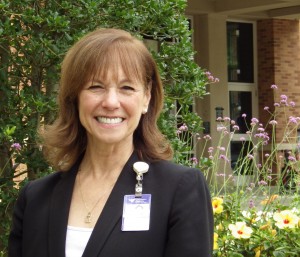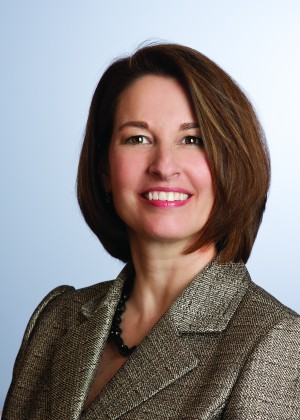The third degree for nursing

- Sue Brown, senior vice president for patient care services at Greenwich Hospital. Photo by Bill Fallon
Sue Brown, senior vice president for patient care services at Greenwich Hospital, said recently of the 700 nurses she oversees, “They are the backbone of patient care.”
Brown”™s counterpart at Bridgeport Hospital, MaryEllen Kosturko, oversees 850 nurses. “We have 650 frontline-bedside of a total 850 nurses,” she said. “Those not involved bedside are in leadership positions, care management, education and they are still providing care away from the bedside. They make an incredible team.”
In past generations, the ranks of nurses have often been filled with graduates of diploma and associate-degree programs. The Bridgeport Hospital School of Nursing has run such a diploma program for 131 years and it now has 120 students enrolled. But it and other programs like it are fading, both administrators said. Kosturko said the Bridgeport program is now transitioning to the University of Bridgeport School of Nursing and a shift to the bachelor of science in nursing (BSN) degree, with the restructuring to be completed by 2017.
“We still have some nurses with associate degrees, but because the science is what it is, you really need a baccalaureate,” Brown said. “We encourage nurses to go back to school. But, of course, that limits the amount of nurses available. This will eventually even out and we will have that much higher a caliber of nurses.”
Brown said Yale New Haven Health has embraced a federally chartered Institute of Medicine initiative to see 80 percent of nurses with a BSN by 2020.
As for nursing shortages that have made headlines in recent years, “I am an optimist,” Brown said. Her confidence is evident, buttressed by the appeal of the profession, “where there are always opportunities to grow. We believe nurses should be encouraged to work closely with physicians. If they have an interest in fertility, we encourage them to pursue those interests through study and different clinical work. Perhaps they will work with bariatric patients. New things arise all the time along with opportunities to study in areas that until recently were not even developed.”
“I think Sue is optimistic because in Connecticut we are fortunate in bachelor-degree programs,” Kosturko said. “The shortage is in nursing faculty. The next pressure is that students need hospitals.” Again, she said, this region is fortunate in number of hospitals.
“The national picture outside Connecticut currently is an easing of the shortage, probably because the economy has kept baby boomers working longer,” Kosturko said. “But at some point in time, with a rapidly aging workforce that includes nurses, by 2025 we will have two times as large a nursing shortage as any shortage we have had since the 1960s.”
An 18-month national study by USr, a health care staffing company, said a 3,259-nurse shortage in Connecticut is predicted by 2030. Nearby, Massachusetts at that time is expected to have a 9,690-nurse surplus; Rhode Island is expected to lack 304 nurses by 2030. While New York is expected to need an additional 39,696 nurses. “Much will come down to where people retire,” Kosturko said.
Kosturko said that, even with the ongoing push for BSN-level nurses, “We”™re keeping the pipeline of new nurses open and this is important.”
At the same time, the path through the pipeline offers greater opportunity. Brown said, “many, many nurses have gone for their master”™s, even Ph.D.s.” Brown, who has an M.S. in nursing and 30 years nursing experience, said she had always envisioned herself a psychiatric nurse, but assisting with her first birth proved momentous and she shifted to obstetrics.
Kosturko, whose Sacred Heart University master”™s degree is in health systems management, spent most of her nonadministrative years as a nurse ”” with a BSN from Fairfield University ”” in the operating room. “In my years in the OR the biggest changes have been technology ”” including robotics ”” and the higher acuity of patients.”
Regarding acuity, she said, “I”™m dating myself, but time was the patient arrived for surgery two days early, got comfortable, maybe got a shave and got ready. Now, the patient arrives the morning of the surgery. Post-op used to be two weeks; now it is three or four days, sometimes one or two. So, beyond the technology, the acuity of the medical condition has increased. That”™s a big change.”
“From preventive care to the sickest patients in the ICU, the beauty of nursing is that it possesses so many avenues that may be specific to your own personality,” Brown said. In the practical world, that could mean one person is drawn to occupational therapy with its interpersonal aspects and another to the technicalities of critical care.Such change can be unsettling, but conversations with Kosturko and Brown revealed only enthusiasm. Said Kosturko, “I love nursing and I”™m very passionate about it.”
Said Brown, “Whatever the discipline, you have to have compassion and the desire to connect with people so you can be part of their health care. For an oncological nurse that might mean helping a person pass through to that other dimension or whatever you choose to believe. Or it could be seeing that perfect baby born. All nurses have different lives, but when we walk through this door we”™re all part of the world of healing.”
Brown said that regardless of the medical path, “Each nurse here has the opportunity to develop expertise and to be a part of the health continuum for the individual.
“It is important that I, as a nurse, understand the medicine,” she said. “The best relationship between a doctor and a nurse is symbiotic and it is an integral part of health care.”
The tsunami of technology that has washed over most industries crested first and fastest in medicine, visible to consumers via magnetic imaging. A less glamorous push ”” toward electronic medical records ”” was completed by the Yale New Haven system in 2012. “We are fully electronic now,” Brown said, a process that “took a lot of work.” Beyond patient data, other developments that require cutting-edge nursing include innovations in diagnostics, robotics and laparoscopic surgery.
To keep up with so many technical and organizational changes, the Yale New Haven system operates so-called shared governance councils, where nurses meet with doctors and management. “We really listen to each other,” Kosturko said.
Bridgeport Hospital became a corporate member of Yale-New Haven Health in 1995 and Greenwich Hospital in 1997. Additionally, St. Raphael Hospital in New Haven, a two-campus, 1,519-bed facility, became part of Yale New Haven in 2012. “It”™s working very well,” said Kosturko. “From a nursing perspective we are able to standardize nursing practices across the entire Yale New Haven system, research the best practices and adopt them.”
